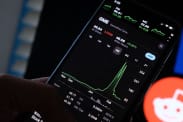Inflation is not the threat that many investors think it is.
That will come as a relief to those who have been spooked by predictions that headline inflation could rise to as much as 4% later this year, or more.
I am devoting this month’s valuation update — a regular feature in this space — to discuss the outlook for inflation. I interviewed Jeffrey Fuhrer, a senior fellow at the Mossavar-Rahmani Center for Business and Government at Harvard’s Kennedy School. He is the former executive vice president and senior policy adviser at the Federal Reserve Bank of Boston.
One of Fuhrer’s research focuses while at the Fed was so-called “inflation persistence,” the tendency for the rate of change of the Consumer Price Index (CPI) to itself change slowly.
A physical analogy is to inertia: The resistance of a body to changing its velocity.
To the extent that inflation rates exhibit a strong tendency to persist, and if it were to rise to 4%, then it would be very concerning to all investors — but particularly to those who focus on stock market
SPX,
Fuhrer says he thinks it unlikely that inflation will stay high after spiking later this year. One reason for his belief is that the inflation persistence that he documented in the historical data was largely caused by earlier decades’ experience, especially the 1970s and 1980s. In the past couple of decades, in contrast, the evidence for inflation persistence has weakened.
This is not an accident, he added. The weakening of inflation’s previous persistence was largely caused by the Fed changing course in the mid-1990s to begin explicitly targeting an inflation rate. As a result of its target, whenever inflation begins to heat up, the Fed works to reverse that uptrend and cause the inflation rate to decline, and vice versa. These reversals are just the opposite of persistence.
Even if inflation persistence were as present and strong as in long-ago decades, however, we still shouldn’t expect inflation to remain persistently high after spiking this summer. That’s because this spike will be the consequence of comparing the CPI to the artificially low-level where it stood 12 months previously. That occurred at the start of the pandemic, when the economy was put into the functional equivalent of a medically induced coma. Over the three months through May of last year, for example, the CPI fell at an annualized rate of 4.4%. That comparison will make the CPI’s 12-month rate of change this year artificially high.
So rather than seeing the inflation as unexpectedly high this summer, it would be more accurate to see the year-ago inflation as artificially low. Its underlying longer-term trend hasn’t changed.
Consider the CPI’s 24-month rate of change, for example, instead of its 12-month change. When this summer the CPI will be as much as 4% higher than where it was one year prior, it will be below 2% on an annualized basis from where it was two years previously.
The bottom line? The true underlying trend of Inflation seems unlikely to stay persistently high after spiking later this year. If it were to do so, of course, we would have to conclude that the stock market is about to become even more overvalued than it already is. So the inflation outlook is good news to that extent.
Status of valuation indicators
Nevertheless, the stock market is undeniably overvalued, as you can see from the table below. It reports the latest values of the eight indicators I report each month in this space. For a full description of how each of the indicators is calculated, please refer to my Oct. 30 column.

Mark Hulbert is a regular contributor to MarketWatch. His Hulbert Ratings tracks investment newsletters that pay a flat fee to be audited. He can be reached at mark@hulbertratings.com.







